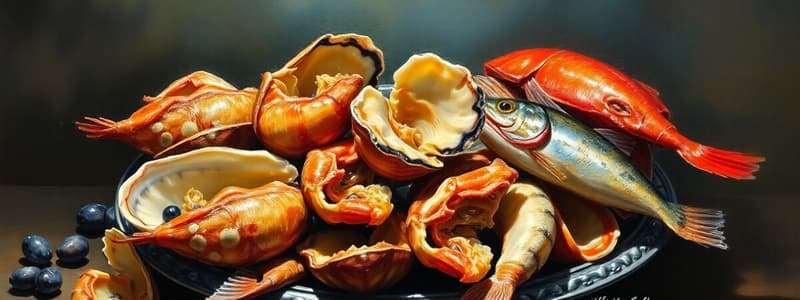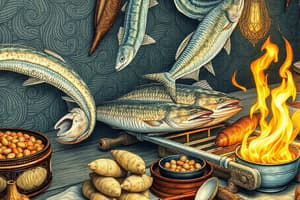Podcast
Questions and Answers
What characterizes a vertebrate in the context of seafood?
What characterizes a vertebrate in the context of seafood?
Vertebrates include finfish and sea mammals, which obtain oxygen from water through gills.
How are invertebrates defined in relation to seafood?
How are invertebrates defined in relation to seafood?
The invertebrate category includes shellfish, most of which have external skeletons or shells, such as crustaceans and mollusks.
Saltwater fish typically have a milder flavor than freshwater fish.
Saltwater fish typically have a milder flavor than freshwater fish.
False (B)
Compared to land animals (15% collagen), what percentage of collagen does fish muscle typically contain?
Compared to land animals (15% collagen), what percentage of collagen does fish muscle typically contain?
Fish muscles are arranged in longer bundles of fibers than those of mammals and birds.
Fish muscles are arranged in longer bundles of fibers than those of mammals and birds.
Match the form of fresh or frozen fish with its description:
Match the form of fresh or frozen fish with its description:
Which of the following characteristics indicate that finfish is fresh? (Select all that apply)
Which of the following characteristics indicate that finfish is fresh? (Select all that apply)
Which of the following are signs of decay in fresh finfish? (Select all that apply)
Which of the following are signs of decay in fresh finfish? (Select all that apply)
Which part of the egg accounts for almost 3/5 (58%) of its total weight?
Which part of the egg accounts for almost 3/5 (58%) of its total weight?
What substance primarily makes up the egg's shell?
What substance primarily makes up the egg's shell?
What natural emulsifying agent found in egg yolks helps stabilize mixtures like mayonnaise?
What natural emulsifying agent found in egg yolks helps stabilize mixtures like mayonnaise?
During cooking, what component of eggs coagulates to act as a binder?
During cooking, what component of eggs coagulates to act as a binder?
The capacity of egg whites to be beaten into a foam that increases to _____ or _____ times its original volume is invaluable in food preparation.
The capacity of egg whites to be beaten into a foam that increases to _____ or _____ times its original volume is invaluable in food preparation.
According to Webster's dictionary, a vegetable is defined specifically as the root part of any plant used as food.
According to Webster's dictionary, a vegetable is defined specifically as the root part of any plant used as food.
Match the vegetable classification based on the plant part to its examples:
Match the vegetable classification based on the plant part to its examples:
Match the major plant pigment group with its typical color(s):
Match the major plant pigment group with its typical color(s):
From a botanical perspective, what defines a fruit?
From a botanical perspective, what defines a fruit?
Match the fruit classification with its description:
Match the fruit classification with its description:
Flashcards
Vertebrate
Vertebrate
Includes finfish and sea mammals; obtain oxygen from water through gills. Finfish are usually found in freshwater or saltwater. Sea mammals include dolphin, whale, and seal.
Invertebrate
Invertebrate
Includes shellfish, which have external skeletons or shells. Examples: crustaceans and mollusks.
Lean or Fat (Fish)
Lean or Fat (Fish)
Fish are sometimes identified by their fat content, but in this case, fat is a relative term.
Collagen in Finfish
Collagen in Finfish
Signup and view all the flashcards
Selection of Finfish
Selection of Finfish
Signup and view all the flashcards
Whole Fish
Whole Fish
Signup and view all the flashcards
Drawn Fish
Drawn Fish
Signup and view all the flashcards
Dressed Fish
Dressed Fish
Signup and view all the flashcards
Steaks (Fish)
Steaks (Fish)
Signup and view all the flashcards
Fillets (Fish)
Fillets (Fish)
Signup and view all the flashcards
Bright, shiny skin
Bright, shiny skin
Signup and view all the flashcards
Emulsifying Eggs
Emulsifying Eggs
Signup and view all the flashcards
Binding Eggs
Binding Eggs
Signup and view all the flashcards
Yolk
Yolk
Signup and view all the flashcards
Albumen
Albumen
Signup and view all the flashcards
Shell Membranes
Shell Membranes
Signup and view all the flashcards
Air Cell
Air Cell
Signup and view all the flashcards
Simple Fruits
Simple Fruits
Signup and view all the flashcards
Aggregates fruits
Aggregates fruits
Signup and view all the flashcards
Multiple fruits
Multiple fruits
Signup and view all the flashcards
Study Notes
Fish and Shellfish
- Vertebrates like finfish and sea mammals get oxygen from water through gills.
- Finfish live in fresh and saltwater environments, while sea mammals include dolphins, whales, and seals.
- Invertebrates, mainly shellfish, have external skeletons or shells like crustaceans and mollusks.
- Saltwater fish tend to have a fuller, salty flavor.
- Fish can be categorized by fat content.
Structure of Finfish
- Fish muscle contains less collagen, about 3%, compared to land animals with approximately 15%.
- Fish are tender due to a lower presence of a certain amino acid.
- Fish muscles are shorter unlike mammals and birds.
Selection of Finfish
- Finfish can be purchased fresh, frozen, canned, cured, or fabricated.
Fresh and Frozen Fish Types
- Whole fish is sold entirely intact, immediately after being caught.
- Drawn fish is whole fish with the entrails removed.
- Dressed fish has the head, tail, fins, scales, and entrails removed.
- Steaks are cuts from dressed fish, sliced at a 90-degree angle from top to bottom fin with varying thickness.
- Fillets are lengthwise slices of fish, from front to back, without bones.
- Butterfly fillet is fish almost completely cut in half.
- Fish sticks are uniform portions from fillets or steaks.
Determining Freshness of Fish
- Sniffing for aroma is the safest way to determine freshness.
- Fresh fish has bright, shiny skin and bulging, jet-black eyes with translucent corneas.
- Fresh fish should have a fresh fish aroma, tight scales, firm flesh, a stiff body, and red gills and lack of a slimy texture.
Signs of Decay in Fresh Finfish
- Decayed fish has concave eyes, gray or creamy brown pupils, and an opaque aroma.
- Gills turn paler brown and may be removed, eyes lose their bright look
Eggs
- Eggs are used to give a foam structure to cakes and meringues and to thicken custards and puddings.
- Eggs add color to lemon meringue pie and eggnog, emulsify mayonnaise and hollandaise sauce, and leaven soufflés and popovers.
- Eggs bind ingredients in meatloaf and casseroles, coat foods before breading, glaze pastries and breads, and clarify liquids for soups.
Composition of Eggs
- The yolk, located in the center, is nutrient-dense.
- Albumen (egg white) is almost 3/5 (58%) of the egg's weight.
- Shell membranes, are located between the egg white and shell, including an inner and outer membrane.
- The air cell is located between the two shell membranes at the larger end of the egg.
- The shell protects the egg contents and is made of calcium carbonate.
Function of Eggs in Foods
- Eggs flavor, color, emulsify, thicken, bind, foam, interfere, and clarify.
- Egg yolks contain lecithin, a natural emulsifier, keeping fat and water from separating.
- Heat coagulates egg protein during cooking, acting as an adhesive to bind ingredients.
- Egg whites can be beaten into a foam increasing to six or eight times its original volume.
Various Egg Products
- Common egg dishes include fried eggs, scrambled eggs, omelets, shirred eggs, meringue, soufflés, hard or soft boiled eggs, quiche, frittata, and poached eggs.
Vegetables and Fruits
- Vegetables are edible plant parts accompanying the main course.
Classification of Vegetables
- Vegetables are classified by the plant part from which they originate:
- Roots: carrots, beets, turnips, and radishes
- Bulbs: onion, leek, spring onions and garlic
- Stems: celery, bamboo shoots and asparagus
- Leaves: spinach and lettuce
- Seeds: beans, corn, and peas
- Flowers: broccoli and cauliflower
- Some fruits are also routinely called vegetables
Plant Pigments
- Plant pigments give vegetables (and fruits) their colors, such as green (leafy vegetables), red and green apples, orange tangerines, or purple.
- Plant pigments fall into carotenoids, chlorophylls, and flavonoids.
Fruits
- Fruits contain seeds and derive from a flower.
Key Distinction: Flavor
- Vegetables come from the Latin "vegere", meaning to invigorate and enliven.
- Fruits come from the Latin "fructus", meaning gratification, pleasure, satisfaction, and enjoyment.
Classification of Fruits
- Simple Fruits develop from one flower like drupes, pomes, and citrus fruits (oranges, grapefruits, etc.).
- Aggregate fruits develop from several ovaries in one flower like blackberries, raspberries, and strawberries.
- Multiple fruits develop from a cluster of several flowers like pineapples and figs.
Studying That Suits You
Use AI to generate personalized quizzes and flashcards to suit your learning preferences.




